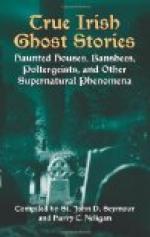But of all the ghosts in that well-haunted house the most unpleasant is that inexplicable thing that is usually called “It.” The lady of the house described to the present writer her personal experience of this phantom. High up round one side of the hall runs a gallery which connects with some of the bedrooms. One evening she was in this gallery leaning on the balustrade, and looking down into the hall. Suddenly she felt two hands laid on her shoulders; she turned round sharply, and saw “It” standing close beside her. She described it as being human in shape, and about four feet high; the eyes were like two black holes in the face, and the whole figure seemed as if it were made of grey cotton-wool, while it was accompanied by a most appalling stench, such as would come from a decaying human body. The lady got a shock from which she did not recover for a long time.
CHAPTER IV
POLTERGEISTS
Poltergeist is the term assigned to those apparently meaningless noises and movements of objects of which we from time to time hear accounts. The word is, of course, German, and may be translated “boisterous ghost.” A poltergeist is seldom or never seen, but contents itself by moving furniture and other objects about in an extraordinary manner, often contrary to the laws of gravitation; sometimes footsteps are heard, but nothing is visible, while at other times vigorous rappings will be heard either on the walls or floor of a room, and in the manner in which the raps are given a poltergeist has often showed itself as having a close connection with the physical phenomena of spiritualism, for cases have occurred in which a poltergeist has given the exact number of raps mentally asked for by some person present. Another point that is worthy of note is the fact that the hauntings of a poltergeist are generally attached to a certain individual in a certain spot, and thus differ from the operations of an ordinary ghost.
The two following incidents related in this chapter are taken from a paper read by Professor Barrett, F.R.S., before the Society for Psychical Research.[6] In the case of the first anecdote he made every possible inquiry into the facts set forth, short of actually being an eye-witness of the phenomena. In the case of the second he made personal investigation, and himself saw the whole of the incidents related. There is therefore very little room to doubt the genuineness of either story.
[Footnote 6: Proceedings, August 1911, pp. 377-95.]
In the year 1910, in a certain house in Court Street, Enniscorthy, there lived a labouring man named Redmond. His wife took in boarders to supplement her husband’s wages, and at the time to which we refer there were three men boarding with her, who slept in one room above the kitchen. The house consisted of five rooms—two on the ground-floor, of which one was a shop and the other the kitchen. The two other rooms upstairs were occupied by the Redmonds and their servant respectively. The bedroom in which the boarders slept was large, and contained two beds, one at each end of the room, two men sleeping in one of them; John Randall and George Sinnott were the names of two, but the name of the third lodger is not known—he seems to have left the Redmonds very shortly after the disturbances commenced.




